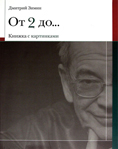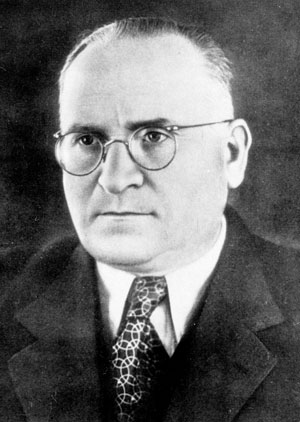
Before that, after graduating from MAI in 1957, I had worked as an engineer in a “Problem Lab” (there used to be places like this) at the department of M.S. Neiman at MAI, where in the spring of 1963 I upheld my Masters dissertation.
Working at the same department was as an instructor, Nina Vasilyevna Trunova, who introduced me to her husband, ‘a big shot at Mintz’s institute,’ the head of the Specialized Department of RTI, Victor Saulovich Kelzon. He told me that work in my field, scanning antennas, ‘was in great demand at RTI,’ and, moreover, that Aleksander Lvovich, naturally, was offering me the position of SSR.
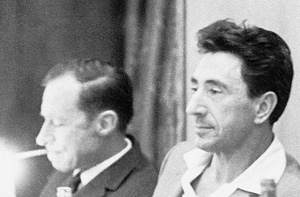 It is 1970. The young Kelzon is in the foreground. And the one lighting a cigarette is Alexei Arkadyevich Kuzmin, who, I think, by then was already a winner of the Lenin Prize (for the Dubna accelerator), and in a few years was to become director of one of the institutes (MRTI) that would branch out of RTI after Mintz’s resignation. The film with these and some other pictures from the last banquet attended by A.L. was passed over to me by L.A. Zorin.
It is 1970. The young Kelzon is in the foreground. And the one lighting a cigarette is Alexei Arkadyevich Kuzmin, who, I think, by then was already a winner of the Lenin Prize (for the Dubna accelerator), and in a few years was to become director of one of the institutes (MRTI) that would branch out of RTI after Mintz’s resignation. The film with these and some other pictures from the last banquet attended by A.L. was passed over to me by L.A. Zorin.
And so, Kelzon took me through the main security point at RTI – I was “on the list” and got through without an ID – lead me up to the third floor, which is called “second” at the Institute, straight to the Director’s office. At almost exactly the appointed time, we were invited into the office of A.L. Mintz.
Thus began my 30-year work at RTI which was to last until the early 1990’s, up to the time of the creation of VympelCom, there, within the walls of the Institute. And I continued spending time there over the following 10 years, until my resignation as the president of VympelCom.
The RTI complex on the 8th Of March Street (parallel to it run, I think, more streets with this type of name: 2nd, 3rd, etc. 8th Of March Street (?!)) looked in the 60’s about the same as in this photo from the 80’s. Only the street looked perhaps a little more provincial: there were tram tracks, and across the way from RTI were wooden houses; the traffic was very light, and instead of trees the buildings were lined with bushes.
The four-story building, a part of which you can see in the photo, used to belong to the Timiryazev Agricultural Academy, and in it, according to old-timers, was the Department of Cattle Breeding; hence the building’s name, The Bulls.
Among other things, The Bulls housed the Communist Party Committee. When, as a result of certain historical events, the rooms used by the Committee were vacated, they were taken over by a group of people who would soon form VympelCom.
This was already a different time … This is how the street with the strange name “8th Of March” looked at the end of the 90’s.
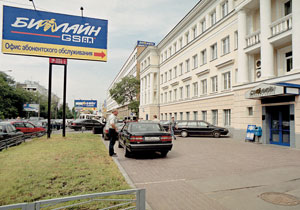 This is where I would come to work almost every day for 40 years. I lived near the Rechnoi Vokzal metro station and sometimes on weekends, on my way not to work but downtown, I would space out and get off the metro train several stops too early, as if on autopilot, and find myself walking the familiar route from the Aeroport metro down Aviatsionny Pereulok, towards RTI.
This is where I would come to work almost every day for 40 years. I lived near the Rechnoi Vokzal metro station and sometimes on weekends, on my way not to work but downtown, I would space out and get off the metro train several stops too early, as if on autopilot, and find myself walking the familiar route from the Aeroport metro down Aviatsionny Pereulok, towards RTI.
By the way, the Rechnoi Vokzal metro line was inaugurated on New Year’s eve of 1965, but my family had moved to the Khimki-Khovrino district back in 1962, when there was no metro, and no stores either. The only transportation was trolleybus ¹ 6 to the Sokol metro station… impassable mud … Nevertheless, none of this did much to dampen our overall sense of joy and wellbeing.
Here are a couple of photographs of the same block in Khimki-Khovrino - in 1962, when my family had just moved there – and now. The church stands at the intersection of Festivalnaya and Smolnaya Streets. This street did not yet exist in the 60’s, the church at the time was located in the village of Aksinyino.
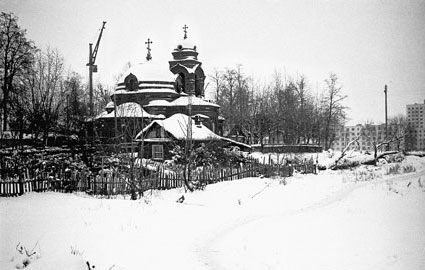
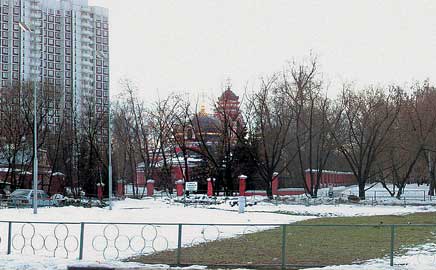
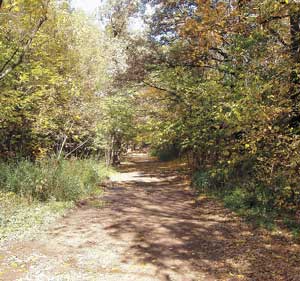
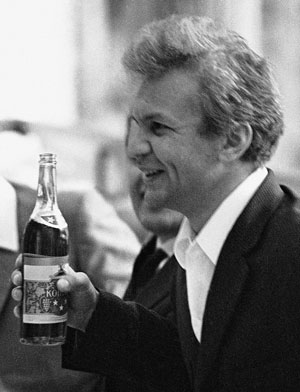 This is my first boss at RTI, Leonid Zorin. The year is 1970. The last farewell banquet with A.L.
This is my first boss at RTI, Leonid Zorin. The year is 1970. The last farewell banquet with A.L.
Before I share my impressions, thoughts, opinions and remembrances of Alexander Lvovich and his (our) institute, I want to say a few words about my early career steps and the ivory towers from which I could observe what was going on in those years long ago.
I began my work at RTI in the Lab of Lyonia Zorin, but was actually part of a small group of lead engineers that included the Chief Design Engineer of Radio Radar System 5N12G (DON-G), and the head of another lab in the same department, whom I will call by the code name R. Subsequently, the decimeter RRS received a centimeter attachment, which over time turned into the RRS DON-2N – the information nucleus of the Moscow Anti-Missile Defense System (code name “A-135”).
I was the lead RRS engineer for antenna components in this group. My task was to be a liaison between the Chief Design Engineer and Department 52, which designed antennas. Even though the Designers technical solutions were far from perfect, we unable to get the production engineers to take our side. Soon enough, within our own Specialized Department, we energetically set out to develop an alternative version of the antenna, which was eventually adopted. Some notes on these designs and their authors can be found in my article in the N. G. Zavaliya’s anthology “Essays On The History Of Space And Rocket Defense” (Moscow, “Veche.” 2003).
With R’s suggestion, the decision on which version to adopt was made by A.L. Mintz himself, who was generally very actively interested in all the work concerning this RRS. I even had the impression (probably erroneous) that he was especially interested in the development of antenna systems. It was Mintz who gave us in the Sample Production Unit of RTI the green light in to construct models of the main components of the proposed antenna system. Incidentally, in those times, the more interest Alexander Lvovich showed in this or that project, as demonstrated by his spending more time than usual reviewing work in the labs, the more help and cooperation you would get from the support units: sample production, the supply department, and the department of measurements, which controlled the pool of measuring instruments. It was somewhat exotic to do experimental work in a Specialized Department whose most complex instruments were telephones and slide rulers. Soon, I was summoned to Alexander Lvovich’s office and was offered the job of setting up and heading up a lab in the Antenna Department, which at the time was presided over by a very colorful woman, Natalia Georgiyevna Orlova, who actively supported this proposal.
Funny that, according to Orlova, her support of this proposal did not mean that she initiated it (“But I couldn’t have been luring Kerzon’s people away from him!,” although, it seems, there were other reasons for that).
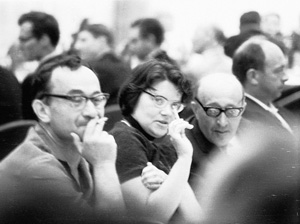 In this picture you see Natalia Georgiyevna Orlova between two colleagues from the new Mintz creation, the Theoretical Department of RTI; the renowned radio-physicist Mikhail Lvovich Levin (smoking, like Orlova); and Sergei Mikhailovich Rytov, a future member of the Soviet Academy of Sciences. They are the authors of the now classic monograph “Statistical Radio Physics.” And the textbook “Limit Conditions of Lentovich-Levin!” A beautiful book of testimonies, first published in Nizhniy Novgorod in 1995, is dedicated to the scientist that was M.L. Levin, his intelligence and his personality. I highly recommend it. Some of the articles and memoirs in this collection reach the level of high literature.
In this picture you see Natalia Georgiyevna Orlova between two colleagues from the new Mintz creation, the Theoretical Department of RTI; the renowned radio-physicist Mikhail Lvovich Levin (smoking, like Orlova); and Sergei Mikhailovich Rytov, a future member of the Soviet Academy of Sciences. They are the authors of the now classic monograph “Statistical Radio Physics.” And the textbook “Limit Conditions of Lentovich-Levin!” A beautiful book of testimonies, first published in Nizhniy Novgorod in 1995, is dedicated to the scientist that was M.L. Levin, his intelligence and his personality. I highly recommend it. Some of the articles and memoirs in this collection reach the level of high literature.
